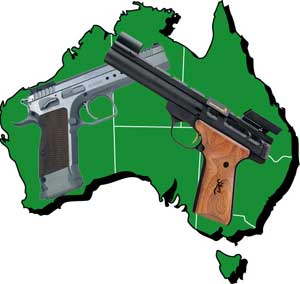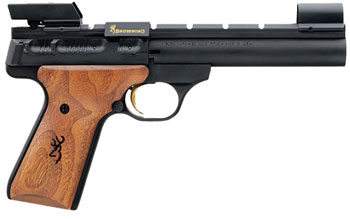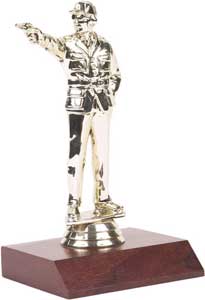The handgun in Australia today
by Geoff Smith
Australian & New Zealand Handgun 1
 Most modern handguns are categorised as either revolvers or
semi-automatics, although there are a few varieties of single shot
handguns principally designed for target matches. As with long guns,
handgun prices range from economy right up to breathtaking, with
quality costing disproportionately more at the top end of the scale.
Handguns tend to cost relatively more than long arms in the same
calibre, perhaps because the volume of the market is relatively much smaller.
Most modern handguns are categorised as either revolvers or
semi-automatics, although there are a few varieties of single shot
handguns principally designed for target matches. As with long guns,
handgun prices range from economy right up to breathtaking, with
quality costing disproportionately more at the top end of the scale.
Handguns tend to cost relatively more than long arms in the same
calibre, perhaps because the volume of the market is relatively much smaller.
The legal classification of handguns in most jurisdictions has been somewhat vague and misleading, with wording along the lines of ‘designed to be fired from one hand’, ‘reasonably able to be concealed’ and so on. It is fair to say though, that most Australian jurisdictions have recognised the potential for misuse of handguns by criminals since about 1930 and have consequently controlled their possession much more strictly than they have long arms.
Legally, while most long arm legislation prescribes a minimum allowable barrel length (typically about 250mm for air rifles, 330mm for rifles, 450mm for shotguns) handguns may be given a maximum barrel length (typically about 400mm). The minimum barrel lengths for recreational (ie, pistol club shooting) handguns imposed with the handgun amendments is 100mm and for semi-automatics 120mm.
In terms of practical designs, handgun barrel lengths can vary from marginally greater than the cartridge in question, through to those that would be equally at home on a rifle. The shorter barrel of the handgun greatly affects user safety. It is much easier to inadvertently line up many parts of one’s anatomy with the business end of a handgun than it is a rifle or shotgun. Indeed, it would be practically impossible to accidentally shoot oneself in the thigh whilst standing with a .22 rifle, yet careless holster practices in the past have led to a number of such injuries with handguns. Similarly, handgun calibres have ranged from the tiny (such as the minuscule 2.7mm Kolibri) through to the titanic, including up to .50 calibre beasts that evolved from the arms race between manufacturers seeking, for the moment at least, to be able to claim ‘mine is the biggest’.
Handgun weights are obviously less than those with rifles, thus recoil is proportionately more of a problem. Recoil momentum (the product of gun mass by gun rearwards velocity) is equal to the forwards momentum of the bullet and gases (the product of their masses and velocities), thus for a particular cartridge, lighter guns smack back into the shooter’s hands harder than heavier ones. Heavier, faster bullets similarly cause more recoil than smaller, slower ones, which explains why target loads tend to be of reduced velocity. Shorter barrels, meanwhile, apart from reducing gun mass (and thus increasing recoil velocity), also generally give lower bullet velocity and higher muzzle blast for a particular calibre.
It is a matter of some curiosity that firearms are rarely classified according to the purposes for which they have been designed. Curious, because firearms are tools and in virtually every other situation tools are classified according to their designated purpose of use.
A carpenter, for example, uses a claw hammer and everybody recognises it as such. Hammers can be used as weapons, but mostly they are used for applying impact forces to items being worked upon. Ignoring the cynical (and patently incorrect) view that firearms have only one use, it quickly becomes obvious that handguns can be employed for many separate and possibly exclusive purposes. They are not simply ‘weapons’ and, in fact, possession of any firearms as weapons is, with very few exceptions, strictly illegal in Australia. A free pistol, for example, is of little use for anything other than matches involving slow, deliberately aimed fire.
Many competition pistols are designed around very tight criteria laid down in the rulebook for that particular match. Having said that, it is still perfectly allowable to use a ‘general purpose’ style of handgun (say a medium price range .22 semi-automatic) for a variety of target matches, including free pistol.
 As with sporting equipment, the beginning pistol shooter is faced with
the law of diminishing returns. Most opt to commence with a
multi-purpose handgun and then, as their skills develop, expand the
collection so that a dedicated handgun is obtained for each match
requiring special features, be they longer barrels or sight radii,
lighter triggers or orthopaedically designed grips.
As with sporting equipment, the beginning pistol shooter is faced with
the law of diminishing returns. Most opt to commence with a
multi-purpose handgun and then, as their skills develop, expand the
collection so that a dedicated handgun is obtained for each match
requiring special features, be they longer barrels or sight radii,
lighter triggers or orthopaedically designed grips.
Only after one’s performance has levelled out should the issue of buying a better handgun for a particular match be considered. The question usually asked is, ‘Can you shoot as well as your gun?’ Until the answer is ‘yes’, little benefit will be gained by spending more money on a better gun.
All too often beginners seek to buy a very powerful handgun straight away. They think bigger is better. The effect of taking up such a piece, though, is that the shooter quickly develops a flinch and consequently starts to lose any skills he or she may have had to begin with. It is probably much better advice to commence with an air pistol and develop skills through vast amounts of practice and with the aid of an experienced coach.
It has been a matter of some controversy between shooters and authorities for years that handguns are not permitted to be used for hunting. Some jurisdictions permit their use by primary producers whose work takes them out on motorcycles into remote country. Under such circumstances, rifles are deemed too bulky to be carried on the bike and so a holstered handgun, usually a revolver, is permitted for such tasks as feral animal control, euthanasia of injured stock and perhaps even self-protection in those areas where a fall from a bike might result in attack by pigs or dingoes.
Revolvers are preferred in such situations because, having fired a shot, the gun must be re-cocked (when shooting single action) or the trigger must be pulled sufficiently to revolve the cylinder to bring the next chamber under the hammer and simultaneously raise the hammer fully before firing. The semi-automatic pistol, having been fired, remains ready to fire until empty. Similarly, although there is a slight hazard from the hot gases escaping out of the gap between the cylinder and barrel with a revolver, the semi automatic usually has a slide that rebounds back over the shooter’s hand and which may cut or bruise any piece of the anatomy that gets in the way.
The optimum barrel length for a handgun similarly is very much dependent upon the purpose for which it is required. A veterinary surgeon might seek to own a small handgun for the purposes of euthanasing animals. In order to fit neatly and discreetly into his or her bag, the obvious choice is something very small. A short barrel length though, means a lightweight gun with more noise and blast. The shorter barrel places the shooter closer to the target with this purpose of use. In contrast, for match shooting the longer the barrel, the closer the muzzle is to the target. It remains a standing joke that for a 25-metre match, but for the rulebook and gravity, the optimum barrel length would be something approaching 25 metres.
Using handguns for veterinary purposes is a specialised skill, especially where large animals are concerned. Apart from needing to know exactly where to aim the gun (usually at the brain-stem), one must be aware of the angle of bullet travel in the animal’s head, the likely reaction of the animal to being shot, whether the animal will fall predictably, whether any limbs may lash out and cause injury while the animal is in its death throes and so on.
 Handguns shouldn’t be used on standing cattle or horse-sized animals
because they place the operator much too close for safety. Even say, at
the race track where a horse is lying on the track, the shooter would
need to get back behind the injured horse, well away from the hooves,
and after clearing all bystanders well away and ensuring soft ground
under the animal’s head, allow a small gap between the gun’s muzzle and
the horse’s head before firing. A screen is usually erected to prevent
bystanders from witnessing this event also, since in this modern world,
certain folk could be subject to suffering post-traumatic stress from
witnessing such an incident.
Handguns shouldn’t be used on standing cattle or horse-sized animals
because they place the operator much too close for safety. Even say, at
the race track where a horse is lying on the track, the shooter would
need to get back behind the injured horse, well away from the hooves,
and after clearing all bystanders well away and ensuring soft ground
under the animal’s head, allow a small gap between the gun’s muzzle and
the horse’s head before firing. A screen is usually erected to prevent
bystanders from witnessing this event also, since in this modern world,
certain folk could be subject to suffering post-traumatic stress from
witnessing such an incident.
The discussion about hunting with handguns, even though it remains academic (since such activity is illegal) generally revolves (if I can be forgiven for such an appalling pun) around the idea of accuracy potential. While most rifle shooters can easily shoot an offhand group of 50mm at say 25 metres using a rifle, using a handgun of similar calibre would result in groups at least several times this size. As an example, it should be possible for a skilled hunter with a rifle to consistently take goats under field conditions (making use of available rests or shooting from the prone position) out to perhaps 150 metres. This assumes a very high proportion of one-shot kills.
Even with a dedicated hunting handgun equipped with long eye-relief scope and of a suitable calibre, very few shooters would be able to take goats at much more than 40 metres. The proof of this can be found in metallic silhouette pistol match scores. Remember, when hunting, the vital area of the animal is far smaller than its outline. The vital area of the typical feral goat would be roughly the size of the chickens that are shot at over 50 metres’ range in the centrefire silhouette match. Very few shooters manage 5/5 with the consistency demanded for ethical hunting and out in the field, conditions are rarely as predictable as they are on the range. On the range, the targets are visually clear and at a known distance. The ground is usually clear and there are flags from which to estimate wind. Most importantly, with a near miss on the range, only one’s pride is hurt.
So, handgun shooting offers a real challenge to those who enjoy shooting, as well as a good deal of variety. Whether you choose the traditional Olympic-style matches like rapid fire, free pistol, standard gun and so on or the more action-based matches like IPSC or single action shooting, the contest greatly exceeds simply seeing who gets the best score.
Handguns are shot with the head as much as the hand. So much environmental information must be taken in and integrated, with total concentration, before the shot can be fired. Apart from the actual shooting, there is also the preparation, which includes reloading the ammo, maintaining the equipment and keeping oneself fit. It is a sport that one can continue to enjoy throughout a lifetime with minimal expense, if this is a problem, and it unquestionably breeds those very personal qualities of mental awareness, self-reliance and discipline that Australia so badly needs in these troubled times. All we need to do now is convince the politicians and policy-makers of the benefits to be obtained by not interfering any more and just letting us get on with it.
